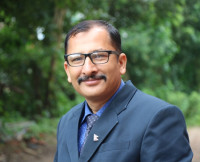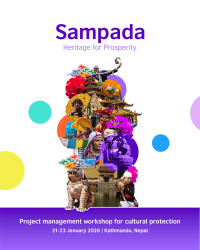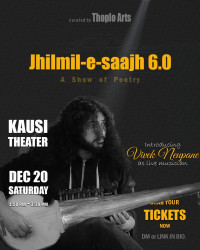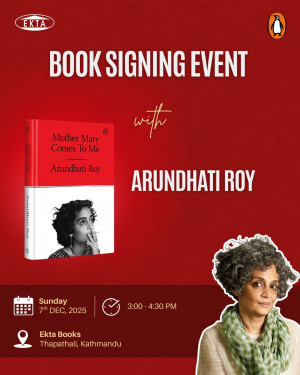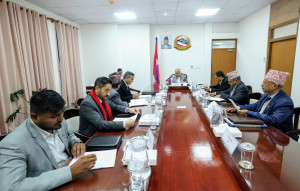Culture & Lifestyle
South Asian women should step outside the bubble they’re given
Pakistani/Canadian filmmaker Anam Abbas discusses her journey, the ethics of storytelling, and her hopes for South Asian cinema.
Reeva Khanal
Anam Abbas is a Pakistani/Canadian filmmaker, producer and cinematographer known for her fearless documentaries and feminist storytelling. Her works—including ‘Showgirls of Pakistan’ and ‘This Stained Dawn’—explore resistance, identity, and the realities of women in South Asia. She is the founder and owner of Other Memory Media, a production company dedicated to amplifying women’s voices and exploring life at the peripheries and transgressive spaces in Pakistan and beyond.
In this conversation with the Post’s Reeva Khanal, Abbas reflects on the politics of representation, the ethics of documentary filmmaking, and why courage is something you build slowly, over time.
You started as a teacher and production coordinator before founding Other Memory Media. What led you to documentary filmmaking, and how did that transition shape your storytelling?
I attended a university in Canada long ago and took a few film courses, though I wasn’t quite sure what I wanted to do with my life back then. I thought I might become a writer. I did my bachelor’s in Cinema Studies and then returned to Pakistan, where I interned at a production house, but the experience didn’t impress me.
So, I returned to Canada and enrolled in a one-year practical film course at Sheridan College. My undergraduate studies were more theoretical, whereas this programme focused on making films. Most schools back home weren’t creatively inclined at the time—we didn’t even have literature courses.
When I came back to Pakistan, teaching became a transitional phase while I figured things out. I’ve always been a bit of a geek, so it made sense at the time. But when I looked around, the only documentaries I could find were the kind made for NGOs, and I struggled to find any real truth in them.
Eventually, I took a leap of faith. In 2014, I founded Other Memory Media. I wanted to make independent films—stories that weren’t tied to the mainstream, and definitely not to NGOs. It was about creating space for alternative narratives, told on our own terms.
Both ‘Showgirls of Pakistan’ and ‘This Stained Dawn’ focus on women navigating resistance and taboo. What draws you to these kinds of stories, and how do you approach them without falling into stereotypes?
Being a South Asian woman is reason enough. I didn’t feel connected to social norms from a very young age—I could see through them. A single mother raised me, so I understood early on what it means to be a woman in South Asia without the protections that come with living an ‘acceptable’ life.
When ‘Showgirls of Pakistan’ came to me, I was interested in performance and entertainment within the working class, and I knew there was so much we, people like me, are shielded from. As women, we’re often discouraged from exploring anything outside our small, protected bubbles, but I was always curious to go beyond that.
When Saad Khan, the director of ‘Showgirls of Pakistan’, approached me with his idea, it felt in tune with what I was already thinking about. So I just dove in. I understood that the lives these women were leading said something powerful about all of our lives—even if theirs were more extreme, more distant from what is considered ‘respectable’. That distance actually gave us room to reflect on the limitations and hypocrisies of respectability itself.
I ended up producing and shooting the film, and it was an experience that affirmed why I want to keep telling these stories.
You were filming This Stained Dawn while also being close to the feminist movement it documents. How did you navigate the personal and political tensions of being both an insider and an observer?
‘This Stained Dawn’ (‘Dagh Dagh Ujala’) began around 2019–2020, several years after ‘Showgirls of Pakistan’. It came from my own experience of living in Karachi and being part of the first Aurat March in 2018. That was a huge cultural moment—it marked the emergence of a visible feminist movement, not just in urban centres but from outside them as well. There was also a lot of backlash in the media.
I wanted to make a film that captured the reality of feminist politics and organising. The mainstream narrative at the time painted the movement as something imported—that it was just elite, upper-class women pushing a Western agenda or funded by NGOs. That wasn’t the truth at all.
I had two key motivations for the film. One was to celebrate my experience as a woman surrounded by friends—women I’ve learned so much from. The other was to counter the myth that this is some kind of fake politics. Most of the film is focused on what it actually means to organise—who these activists are, the work they’re doing, and the many intersecting movements they’re a part of.
While making all these women-centric films, what does feminism actually mean to you?
There’s a definition I like—that feminism means being free to live your life on your own terms, and free from violence. I think, for many people, feminism is something that evolves throughout their lives, as they evolve and re-educate themselves.
Some young people come to understand feminism through what they learn online, others through personal experiences. It’s not a fixed idea. But for me, it remains an evolving experience, a perspective through which I view the world. It’s not static; it grows with you.
How do you ensure ethical representation when documenting marginalised communities, especially women whose voices are rarely heard?
I think it’s a major issue, especially in documentary making. In the West, there’s a lot of talk around inclusion and diversity, but it often centres only on identity politics—and doesn’t always include social class. That gap becomes even more pronounced in South Asia, where access and class divisions are far more stratified.
The reality is, in our region, most people working in the documentary industry—even women—tend to come from upper-class backgrounds. In countries where caste plays a significant role, that complicates things even further. Access to equipment, training, time, mobility—all of these are luxuries, and filmmaking is expensive. So, it’s not just about who wants to tell stories, but who can.
Women’s mobility is also influenced by social class. Who gets to travel to another town, stay there, and make a film? These are fundamental questions, and it’s important that we, as filmmakers, keep interrogating our own positions and privileges.
‘Showgirls of Pakistan’ took seven years to make, and that time was necessary to build relationships and trust. With ‘This Stained Dawn’, it was different—that story came from within my own community. There’s often an external desire, particularly in Muslim contexts, to tell stories that paint women as oppressed. But our film wasn’t about victimhood. It was about misogyny but also about resistance, joy, and celebrating women living life on their own terms.
You’ve participated in global labs like Berlinale Talents, Cannes’ Producers Network, and others. How have these experiences shaped your approach to filmmaking?
Berlinale is a big German festival, and Cannes is a French one—both have huge markets attached to them. My experiences there have mostly been on the business side of things. But it’s still a privilege to be in those spaces. You gain an understanding of how the global film market operates, and you get to take a lot of meetings.
Having these names attached to your profile is helpful—it gives your work visibility, opens doors, and helps with networking. If you’re aiming for an international career, it makes a difference when these festivals take an interest in your work.
Cannes was particularly special because we were screening a film there. That came with a bit of glamour—you’re at the beach, it’s beautiful, and you feel seen by an international audience. I remember Anurag Kashyap came to watch our film—he was kind, hung out with everyone, and was encouraging. Those cross-border, international connections are so valuable. That’s the beauty of festivals, even regional ones like Kathmandu International Mountain Film Festival (KIMFF)—they create spaces for us to meet, to connect. That’s why we make films, right? To communicate, to be heard.
Of course, there’s also the business side—it helps to have recognition from these festivals. But I’ll be honest, I’m at a point where I’ve been feeling quite disillusioned. Over the past couple of years, we’ve seen just how morally compromised some of these institutions are. They’re not always interested in the values they claim to uphold. So, while the exposure is great, I think it’s equally important to stay grounded and remember why we’re doing this in the first place.
Looking ahead, what kinds of stories are you eager to tell through your documentaries? What projects are you working on?
A lot of filmmakers have turned more inwards over the last couple of years, especially after the pandemic. Right now, I’m working on a project that’s personal—I’m Kashmiri, and this film explores my family, separated by the border, and the violence of occupation. It is important to me.
I’m also interested in stories about the impact of climate change on communities in South Asia. These are heavy, challenging topics, but the kind of stories that often come to you rather than ones you go looking for. That’s generally how I approach my work.
So yes, my upcoming projects largely revolve around these themes. I’m currently in development, but I’m also rethinking how I want to shape my career and the kind of work I want to do going forward. I’ve taken a year-long break, which has just ended, and now I’m preparing to return to filmmaking, but with a slower, more deliberate pace.
You’re here in Kathmandu to mentor emerging documentarians at the first-ever documentary lab under KIMFF. What are you looking forward to, and what do you hope to bring into these sessions as a mentor?
I hope we can have warm, positive interactions with each other. While we’re called ‘mentors’, I see us as peers—we’re all in the same boat, navigating similar challenges.
I’ve previously mentored Nepali filmmakers online through KathaHaru, and I enjoyed that experience. I think it’s such a valuable process—openly sharing your ideas with peers and receiving feedback. That kind of exchange is important for anyone, but especially for filmmakers, because the ecosystem isn’t always developed enough to offer that kind of regular support.
Labs like this allow filmmakers to reflect deeply—why are you making this film? What are you trying to say? How do you plan to do it? Documentary filmmaking is full of uncertainty, so it helps to think about your story, your characters, and especially your intention—what impact do you want your film to have? How do you want it to make people feel?
A mix of a safe, supportive space and productive challenge can be helpful. We’ll also be doing practice pitch sessions, which I think are great. They push you to be clear and concise about what your film is actually about. As artists, we sometimes get carried away talking for hours and still leave the listener confused. So this is about finding clarity, purpose, and confidence in your story and storytelling.
When I look at your work, I see it as something beyond cinema—it lends strength to activism, empowers, and shifts narratives. What’s your perspective on your journey? Who or what inspired you to take that bold step into making such influential films, especially in a region where women often don’t feel encouraged to lead?
Courage is something that comes with time. You don’t just wake up one morning and feel brave—it’s a muscle you keep exercising, over and over. Even now, I’m often afraid of the films I’m working on, though the fear is different. It’s not about whether I can make a film anymore, it’s more about the creative or political ambition behind it—whether I’ll be able to say what I truly want to say.
I was raised by a single mother, so from a very early age, I had a different kind of blueprint. There wasn’t a man dominating the household. I realise now how much of a privilege that was—there were certain battles I didn’t have to fight, and that gave me space to imagine and grow. Going to film school abroad also helped. Of course, patriarchy exists everywhere, but in those environments, you’re given a little more room to fail—and that’s crucial. Because in very patriarchal spaces, when women make mistakes, the punishment is often harsher. You might be humiliated, or just not get a second chance. That kind of fear can be paralysing.
In Pakistan, I’ve seen how male film students often form supportive networks—they graduate, make films together, and grow by doing. For many women, that same safety and support isn’t guaranteed. Working with men doesn’t always mean being in a creatively nurturing or logistically safe space—even something as basic as getting home late can be a barrier.
Collaborating with other women has been transformative for me. In creative, queer, or feminine spaces, the elements of humiliation, fear, and violence that often hold us back aren’t there. It’s freeing. And I think those feminine spaces that value care and emotional safety are vital for creative growth. That’s something I’ve come to value deeply on this journey.




 18.12°C Kathmandu
18.12°C Kathmandu
